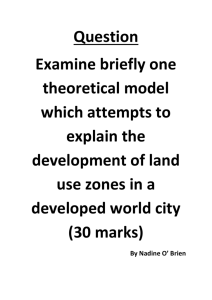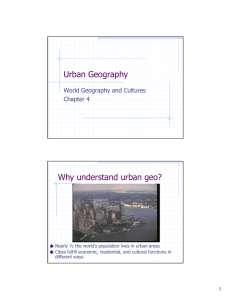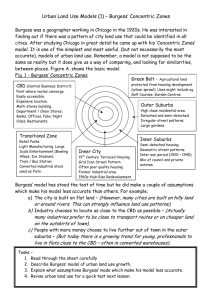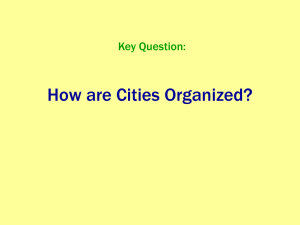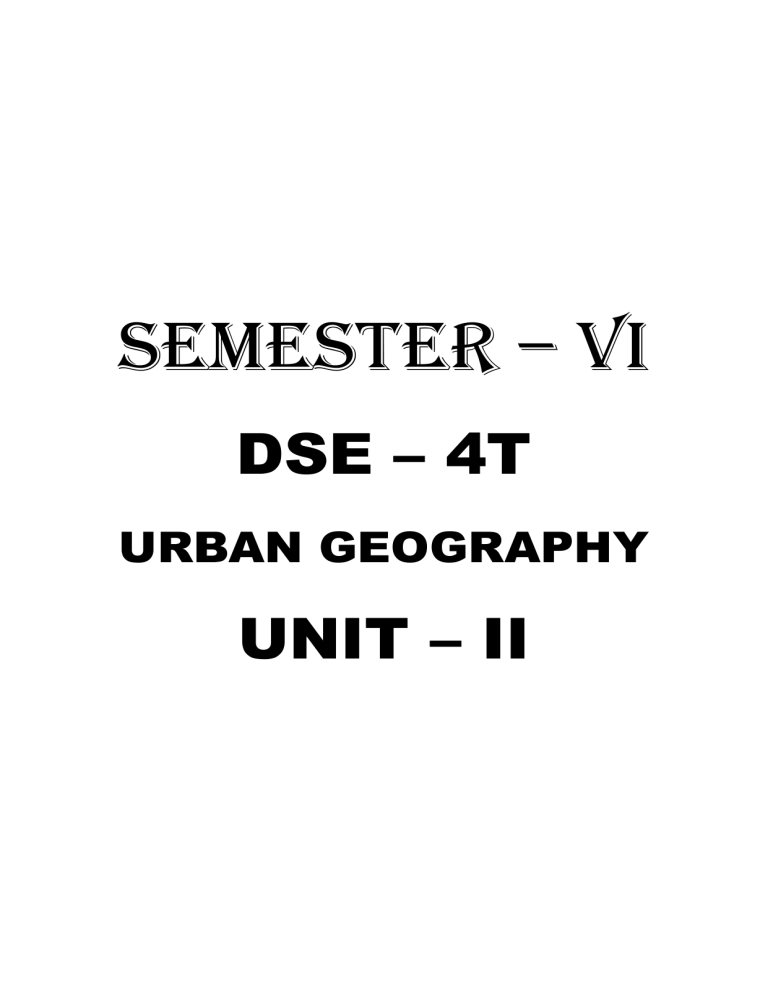
SEMESTER – VI DSE – 4T URBAN GEOGRAPHY UNIT – II CONCENTRIC ZONE MODEL The concentric zone model, also known as the Burgess model or the CCD model, is one of the earliest theoretical models to explain urban social structures. It was created by sociologist Ernest Burgess in 1925, Based on human ecology theory done by Burgess and applied on Chicago, it was the first to give the explanation of distribution of social groups within urban areas. This concentric ring model depicts urban land usage in concentric rings: the Central Business District (or CBD) was in the middle of the model, and the city is expanded in rings with different land uses. It is effectively an urban version of Von Thünen's regional land use model developed a century earlier. It influenced the later development of Homer Hoyt's sector model (1939) and Harris and Ullman's multiple nuclei model (1945). The model is more detailed than the traditional down-mid-uptown divide by which downtown is the CBD, uptown the affluent residential outer ring, and midtown in between. This theory states that the concentric circles are based on the amount that people will pay for the land. This value is based on the profits that are obtainable from maintaining a business on that land. The center of the town will have the highest number of customers so it is profitable for retail activities. Manufacturing will pay slightly less for the land as they are only interested in the accessibility for workers, 'goods in' and 'goods out'. Residential land use will take the surrounding land. ASSUMPTIONS 1. 2. 3. 4. 5. 6. Cultural and social heterogeneity of the population Commercial – industrial base to the economy of the city Private ownership of property and cheap in ever direction within the city Expending area and population of the city Transport is equally easy , rapid and cheap in ever direction within the city The city center is the main center for employment and near this center space is limited; competition for this space is high , and therefore it is most valuable 7. No concentrations heavy industry 8. No historic survival of and earlier land use pattern in any district DIFFERENT ZONE IN THE BURGESS MODEL OR CONCENTRIC ZONE MODEL Various researchers and scholars have debated over the number of zones (concentric circles) in the Burgess concentric zone model. Some consider them to be five whereas some consider 6 zones to explain this urban land use model. The center is the oldest part of the city around which the city expands over time, and the newest development comes on the edges. Some people also refer this model as concentric circle theory because of the arrangements in form of circles. These circles are often referred to as rings by a few. The zones identified are: 1. The center with the central business district, 2. The transition zone of mixed residential and commercial uses or the zone of transition, 3. Working class residential homes (inner suburbs), in later decades called inner city or zone of independent working men's home, 4. Better quality middle-class homes (outer suburbs) or zone of better housing, 5. Commuter zone. Zone I (Central Business District) – This is the center (innermost zone) where the central business district is located and has highest land value. The zone has tertiary activities and earns maximum economic returns. Another feature is the accessibility of the area because of the convergence and passing of transport networks through this part from surrounding and even far places in the city. This part has tall buildings and noticeably high density to maximize the returns from land. Commercial activity taking place in the area results in negligible residential activity in this zone. Zone II (Transition Zone) – The mixed residential and commercial use characterizes this zone. This is located adjacent and around the CBD and is continuously changing, i.e. transition takes place. Another feature is the range of activities taking place like mixed land use, car parking, cafe, old buildings. This zone of transition is considered to “decay” because of a large number of old structures as the buildings in transition zone were earlier used for factories and tenement housing blocks. This zone had a high population density when industrial activities were at their peak. Those residing in this zone were of the poorest segment and had the lowest housing condition. Zone III (Inner City/ Working Class zone) – This area is occupied for residential purpose and also known as “inner city” or “inner suburbs.” It consisted of houses built to accommodate factory workers but had better condition than the transition zone. This area has a mix of new and old development and generally requires orderly redevelopment. People living in this zone are second generation immigrants as many moves out of the transition zone to this zone whenever affordable. This zone is nearest to the working area with modest living conditions, and this resulted in reduced commuting cost. Another interesting feature includes the large rental housing occupied by single workers. Zone IV (Outer Suburbs/ White Collar Homes) – This zone had bigger houses and new development occupied by the middle class. Many of the homes are detached, and unlike single occupants of inner suburbs, families resided in these homes. Better facilities are available to the residents like parks, open spaces, shops, large gardens but this comes at an increased commuting cost. This zone has a large area of residential land. People living in this outer ring look for better quality of life. Zone V (Commuter Zone) – This is the peripheral area and farthest from the CBD, this resulted in highest commuting cost when compared with other zones. Significant commuting cost gave the name “commuter zone” to this part. People living in this part were high-income groups which could afford large houses could pay commuting charges, had access to different transportation mode; enjoy modern facilities like shopping malls. Low rise development, large gardens, less population density is some of the characteristics of this zone. This zone offered the highest quality of life and facilities but at a cost of higher commuting cost. Burgess applied his model to Chicago, CRITICISMS The model has been challenged by many contemporary urban geographers. First, the model does not work well with cities outside the United States, in particular with those developed under different historical contexts. Even in the United States, because of changes such as advancement in transportation and information technology and transformation in global economy, cities are no longer organized with clear "zones" • • • • It describes the peculiar American geography, where the inner city is poor while suburbs are wealthy; the converse is the norm elsewhere. It assumes an isotropic plane – an even, unchanging landscape. o Physical features – land may restrict growth of certain sectors; hills and water features may make some locations unusually desirable for residential purposes. Commuter villages defy the theory, being a distant part of the commuter zone. Decentralization of shops, manufacturing industry (see Industrial suburb), and entertainment. • • • • Urban regeneration and gentrification – more expensive property can be found in formerly 'low class' housing areas. Many new housing estates were built on the edges of cities in Britain. It does not address local urban politics and forces of globalization. The model does not fit polycentric cities, for example Stoke-on-Trent
